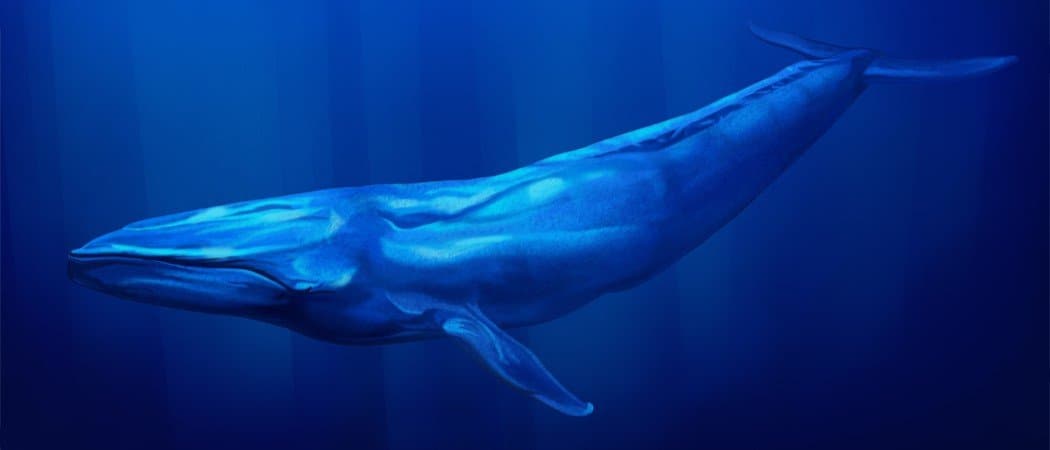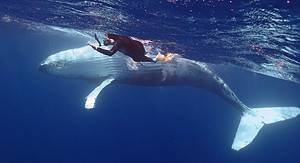The biggest cetacean in the world is the blue whale, whose scientific name is Balaenoptera musculus. Despite some people’s claims of certain dinosaurs growing longer than 100 feet, this beast is the biggest animal that has ever lived. It is possible for it to grow to 100 feet in length, but not much longer. Despite its great size, the blue whale is rather elusive. No one, for example, has ever seen two blue whales mate or seen one give birth. As it is endangered, it can no longer be collected for study, and some of what scientists know about it is inferred. Here are some things people do know about this awesome animal.
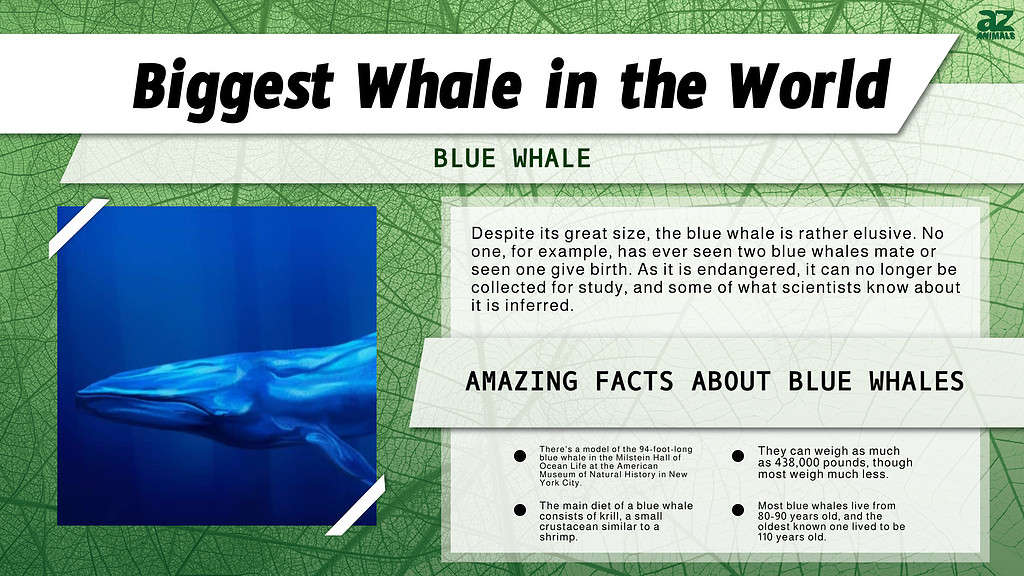
What Does it Look Like?
The blue whale is fusiform, which means it is shaped like a spindle that tapers towards both ends. This cetacean tapers mostly toward its tail. It is light blue-gray above and sometimes mottled with gray. Seen through the water, it looks blue. The belly is sometimes yellow, which gives the animal its other name of Sulfur Bottom. The yellow isn’t the animal’s natural coloring but is caused by diatoms that cling to its belly as it swims in cold waters.
The blue whale has a row of bristly parallel plates in its upper jaw called baleen. Baleen, which is made of the same stuff as fingernails, is used to sift its food out from the water. The animal has a broad, flat beak or rostrum that’s almost shaped like a U. It has a ridge down the center of its back and has two blowholes. When it comes up for air, the blow is high and shaped like an oval. The dorsal fin is very small, shaped like a triangle, and rather far back on the tail. The animal also has grooves on its throat that extend just past its navel. These grooves allow the throat to expand as it takes in food and water. When the blue whale dives, it lifts its tail out of the water. This is called fluking, and not every whale does this.
How Big Is It?
People who visit the American Museum of Natural History in New York City can’t help but see the model of the 94-foot long blue whale in the Milstein Hall of Ocean Life. It actually hangs from the ceiling and dominates the entire space. This specimen is considered large for the species, for the biggest of these marine mammals average a little more than 86 feet long. It is unusual for a blue whale to be much larger than this. Scientists believe that these animals can’t grow more than 108 feet long because it would take too much energy to maintain a body that size. Females, by the way, are larger and heavier than males.
Besides being long, the weight of the cetacean can be as much as 219 short tons, or 438,000 pounds though again most blue whales weigh much less than this.
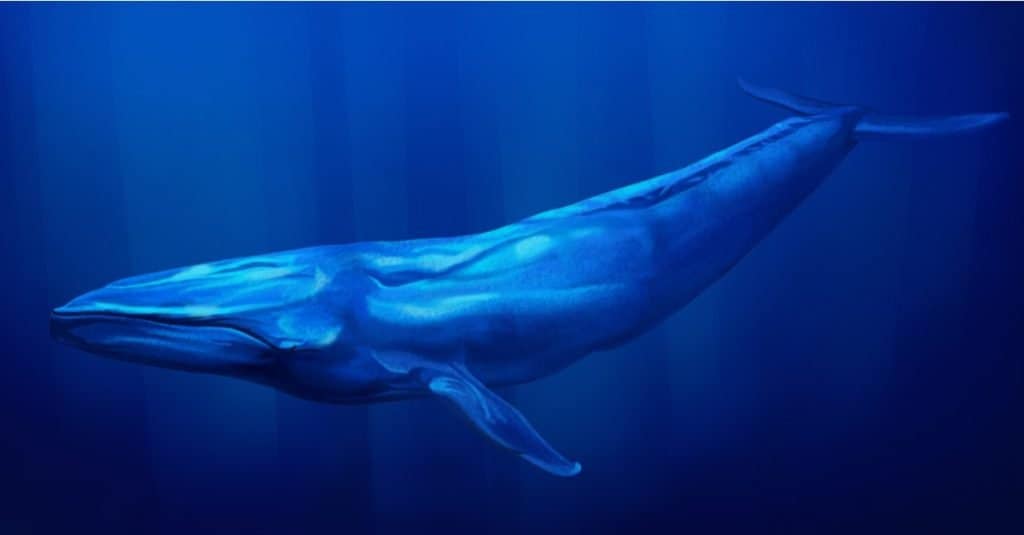
Blue Whale under water with sun light streaming down from the surface above
©Atomic Roderick/Shutterstock.com
Why Is It So Big?
Nature has allowed blue whales to grow so big — even though its terrestrial ancestor was about the size of a cat — because it now lives in the ocean. The ocean is not only big enough to accommodate a lot of creatures the size of Balaenoptera musculus, but the growth of the animal isn’t constrained by gravity the way it would be if it still lived on land.
How Many Species of Blue Whale Are There?
There are about four species of blue whale, plus numerous subspecies. These subspecies live in different seas around the world. They are:
1. Balaenoptera musculus musculus
2. Balaenoptera musculus intermedia
3. Balaenoptera musculus brevicauda
4. Balaenoptera musculus indica
The subspecies have been divided into groups found in the eastern part of the North Pacific; the central and western part of the North Pacific; the North Atlantic and the Northern Indian Ocean. They’re also found in the waters around Madagascar, Chile, Indonesia and Western Australia and New Zealand and Eastern Australia.
Where Do Blue Whales Live?
As can be seen, these marine mammals live in seas and oceans all around the world, however, compared to the Northern Hemisphere their population is higher in the Southern hemisphere. The animals have also been known to visit the shallow waters near the shore and have been seen off the coast of California and Mexico. Some migrate to feeding grounds and breeding grounds, while some stay in the same place all year.
What Does it Eat?
Most populations of blue whale famously eat krill, a tiny crustacean that resembles a shrimp and is related to it. Depending on the time of year, the cetacean can eat four tons of krill every day. Yet, there are so many krill in the ocean that they can sustain the population of not only blue whales but other baleen whales, marine animals such as penguins and seals and humans. When the blue whale eats, it simply opens its mouth and lunges forward into a great cloud of krill. The ventral pleats allow its throat to expand like a bellows. Then, it uses its baleen to strain much of the the water out of its mouth and swallows the krill.
Krill are known to practice vertical migration, which means that during a 24 hour period they rise toward the surface of the ocean then sink towards the bottom. Whales feed on krill that are at the top of their migration, in the middle and near the bottom.
Whales consume an average of 4 tons of krill a day. And the waste that the blue whale expels, referred to as ambergris, serves an ecological purpose in acting as a fertilizer, as well as aiding in the creation of ocean algae. It’s also used in the perfume industry, so it’s a hot commodity for humans, and its retail price is quite expensive.
Does Anything Eat the Blue Whale?
Other animals are not remotely big, strong or smart enough to prey on a blue whale. The exceptions, of course, are humans who were smart enough to build whaling vessels and killer whales, or orcas who are smart enough to hunt in packs and at least try to take on a blue whale. Though scientists don’t know how many blue whales are actually killed by orcas, they’ve seen a good number of them with bite marks that they assume came from killer whales. Orcas have been known to successfully prey upon blue whale juveniles, but adults seem able to escape them even after being harassed for hours.
What Are Other Threats?
Thanks to the International Whaling Commission, blue whales are no longer hunted, something which nearly drove them to extinction. However, they do face a lot of other threats. They are still hit and killed by ships. A few have been entangled in fishing gear, and ocean noise disorients them. Their health is impacted by pollution, including plastic. Climate change impacts blue whales adversely because it can reduce the population of krill or make krill harder to find.
How Fast Does it Swim?
The blue whale, not surprisingly, is not the ocean’s fastest swimmer. A blue whale who is trying to evade a pod of killer whales might reach 20 miles per hour. Killer whales can achieve 28 miles per hour but only in short bursts.
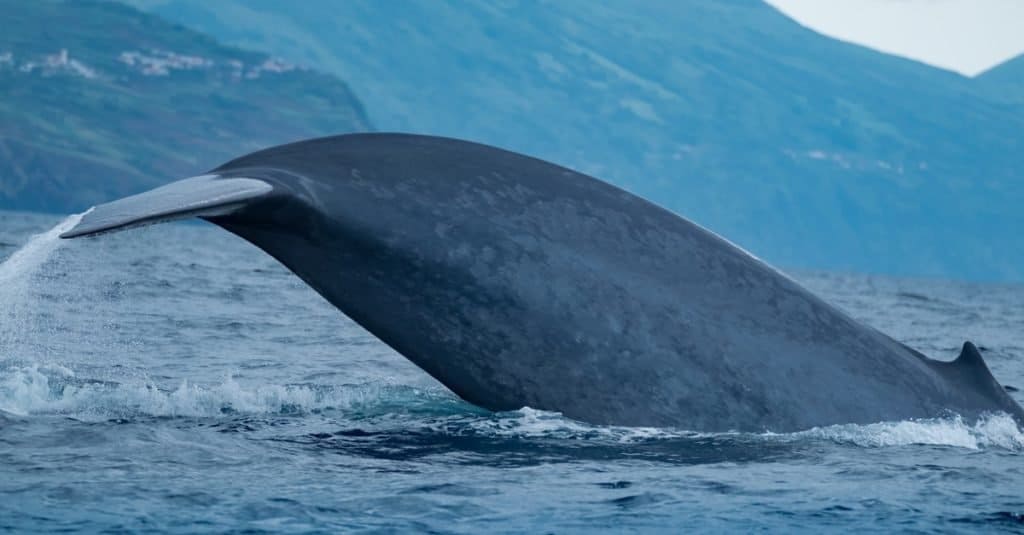
The
biggest animal
in the world, a blue whale showing its back from dorsal fin to tail flukes
©Wild_and_free_naturephoto/Shutterstock.com
Reproduction and Babies
How blue whales make other blue whales is one of the more mysterious things about them. Scientists speculate that a female, or cow is ready to breed when she’s about 10 years old or is 77 feet long, at least if she’s from Antarctica. Males, or bulls may be ready to breed about a year earlier, and there may be some populations that achieve reproductive maturity when they’re as young as five years old. These whales are believed to breed in the fall and winter, and females give birth after a pregnancy that lasts between 10 months and a year. This is considered a short amount of time for such a big animal. The much smaller African elephant is pregnant for nearly twice as long. Blue whale cows usually have a baby every two or three years.
When the calf is born it’s 23 feet long, and its weight is 6200 pounds. Its mother nurses it until it’s about seven or eight months old or 53 feet long. The milk of whales is full of fat, and the calf gains about 198 pounds of weight every day just from ingesting it. This means that the mother needs to produce an average of 490 pounds of milk every day.
Do Blue Whales Sing?
Blue whales do “sing,” but their vocalizations are not nearly as complex as those of humpback whales. Still, scientists can distinguish a population of whales by their vocalizations. The vocalizations also vary depending on the season, where the animal lives, what it’s doing at the moment and whether it’s morning, afternoon or night. What distinguishes the song of the blue whale is that it is loud and low. This animal can produce a sound that is as loud as 180 decibels, which is louder than a jet engine. The frequency is most often between 8 and 25 Herz. The latter frequency just about enters the range of human hearing.
Because the vocalizations are so loud and so low, they are able to travel as much as 500 miles through the ocean. Whales use their vocalizations to both talk to other whales far away and to navigate.
How Long Do They Live?
Scientists estimate that blue whales live about 80 to 90 years in the wild, though the oldest known lived to be 110. How scientists figure out how long blue whales live is interesting. As the animal matures, its ears produce earwax that eventually forms a plug. The layers of wax, like the rings in a cross-section of a tree trunk, tell the scientist the whale’s age. By the way, the earwax doesn’t interfere with the whale’s ability to hear, but actually enhances it by transmitting sound waves.
Thank you for reading! Have some feedback for us? Contact the AZ Animals editorial team.

